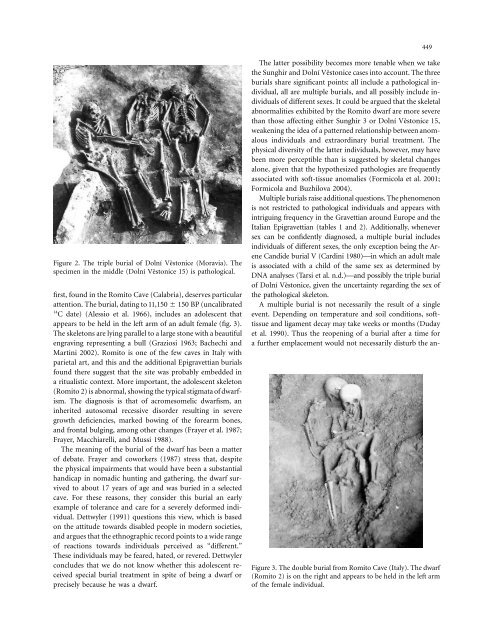From the Sunghir Children to the Romito Dwarf
From the Sunghir Children to the Romito Dwarf
From the Sunghir Children to the Romito Dwarf
Create successful ePaper yourself
Turn your PDF publications into a flip-book with our unique Google optimized e-Paper software.
Figure 2. The triple burial of Dolní Věs<strong>to</strong>nice (Moravia). The<br />
specimen in <strong>the</strong> middle (Dolní Věs<strong>to</strong>nice 15) is pathological.<br />
first, found in <strong>the</strong> Romi<strong>to</strong> Cave (Calabria), deserves particular<br />
attention. The burial, dating <strong>to</strong> 11,150 150 BP (uncalibrated<br />
14C date) (Alessio et al. 1966), includes an adolescent that<br />
appears <strong>to</strong> be held in <strong>the</strong> left arm of an adult female (fig. 3).<br />
The skele<strong>to</strong>ns are lying parallel <strong>to</strong> a large s<strong>to</strong>ne with a beautiful<br />
engraving representing a bull (Graziosi 1963; Bachechi and<br />
Martini 2002). Romi<strong>to</strong> is one of <strong>the</strong> few caves in Italy with<br />
parietal art, and this and <strong>the</strong> additional Epigravettian burials<br />
found <strong>the</strong>re suggest that <strong>the</strong> site was probably embedded in<br />
a ritualistic context. More important, <strong>the</strong> adolescent skele<strong>to</strong>n<br />
(Romi<strong>to</strong> 2) is abnormal, showing <strong>the</strong> typical stigmata of dwarfism.<br />
The diagnosis is that of acromesomelic dwarfism, an<br />
inherited au<strong>to</strong>somal recessive disorder resulting in severe<br />
growth deficiencies, marked bowing of <strong>the</strong> forearm bones,<br />
and frontal bulging, among o<strong>the</strong>r changes (Frayer et al. 1987;<br />
Frayer, Macchiarelli, and Mussi 1988).<br />
The meaning of <strong>the</strong> burial of <strong>the</strong> dwarf has been a matter<br />
of debate. Frayer and coworkers (1987) stress that, despite<br />
<strong>the</strong> physical impairments that would have been a substantial<br />
handicap in nomadic hunting and ga<strong>the</strong>ring, <strong>the</strong> dwarf survived<br />
<strong>to</strong> about 17 years of age and was buried in a selected<br />
cave. For <strong>the</strong>se reasons, <strong>the</strong>y consider this burial an early<br />
example of <strong>to</strong>lerance and care for a severely deformed individual.<br />
Dettwyler (1991) questions this view, which is based<br />
on <strong>the</strong> attitude <strong>to</strong>wards disabled people in modern societies,<br />
and argues that <strong>the</strong> ethnographic record points <strong>to</strong> a wide range<br />
of reactions <strong>to</strong>wards individuals perceived as “different.”<br />
These individuals may be feared, hated, or revered. Dettwyler<br />
concludes that we do not know whe<strong>the</strong>r this adolescent received<br />
special burial treatment in spite of being a dwarf or<br />
precisely because he was a dwarf.<br />
449<br />
The latter possibility becomes more tenable when we take<br />
<strong>the</strong> <strong>Sunghir</strong> and Dolní Věs<strong>to</strong>nice cases in<strong>to</strong> account. The three<br />
burials share significant points: all include a pathological individual,<br />
all are multiple burials, and all possibly include individuals<br />
of different sexes. It could be argued that <strong>the</strong> skeletal<br />
abnormalities exhibited by <strong>the</strong> Romi<strong>to</strong> dwarf are more severe<br />
than those affecting ei<strong>the</strong>r <strong>Sunghir</strong> 3 or Dolní Věs<strong>to</strong>nice 15,<br />
weakening <strong>the</strong> idea of a patterned relationship between anomalous<br />
individuals and extraordinary burial treatment. The<br />
physical diversity of <strong>the</strong> latter individuals, however, may have<br />
been more perceptible than is suggested by skeletal changes<br />
alone, given that <strong>the</strong> hypo<strong>the</strong>sized pathologies are frequently<br />
associated with soft-tissue anomalies (Formicola et al. 2001;<br />
Formicola and Buzhilova 2004).<br />
Multiple burials raise additional questions. The phenomenon<br />
is not restricted <strong>to</strong> pathological individuals and appears with<br />
intriguing frequency in <strong>the</strong> Gravettian around Europe and <strong>the</strong><br />
Italian Epigravettian (tables 1 and 2). Additionally, whenever<br />
sex can be confidently diagnosed, a multiple burial includes<br />
individuals of different sexes, <strong>the</strong> only exception being <strong>the</strong> Arene<br />
Candide burial V (Cardini 1980)—in which an adult male<br />
is associated with a child of <strong>the</strong> same sex as determined by<br />
DNA analyses (Tarsi et al. n.d.)—and possibly <strong>the</strong> triple burial<br />
of Dolní Věs<strong>to</strong>nice, given <strong>the</strong> uncertainty regarding <strong>the</strong> sex of<br />
<strong>the</strong> pathological skele<strong>to</strong>n.<br />
A multiple burial is not necessarily <strong>the</strong> result of a single<br />
event. Depending on temperature and soil conditions, softtissue<br />
and ligament decay may take weeks or months (Duday<br />
et al. 1990). Thus <strong>the</strong> reopening of a burial after a time for<br />
a fur<strong>the</strong>r emplacement would not necessarily disturb <strong>the</strong> an-<br />
Figure 3. The double burial from Romi<strong>to</strong> Cave (Italy). The dwarf<br />
(Romi<strong>to</strong> 2) is on <strong>the</strong> right and appears <strong>to</strong> be held in <strong>the</strong> left arm<br />
of <strong>the</strong> female individual.

















